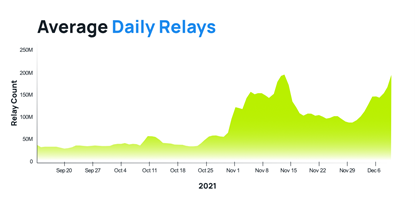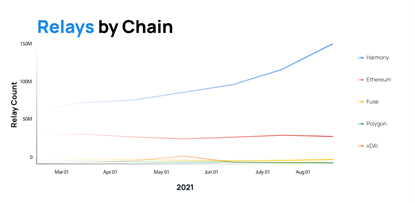According to Web3Index (https://web3index.org/), Pocket Network is now the number one middleware service protocol, and developer payments grew 208% last month, more than seven times higher than the closest protocol by revenue, while the entire network last month Revenue was up 322%.
Pocket Network is a blockchain data ecosystem for Web3 applications. Generated $1.45 million in demand-side fees and $29.5 million in total web revenue in the past 30 days, becoming the #1 middleware service protocol on the industry-recognized Web3Index.
The Web3Index index specifically includes and showcases leading blockchain middleware protocols such as Arweave, The Graph, Livepeer, Akash, and Hemium, and the current ranking of Pocket Network is 7 times the demand-side fees generated by Arweave, which is 163 times the revenue of The Graph in November times.
The explosive growth of Pocket Network's total network revenue in the first few months has contributed to its achievement of this important milestone, the data is as follows:
July: 107%
August: 316%
September: 222%
October: 304%
November: 322%
"When we first approached Web3Index and showed them our on-chain data, they were amazed," said Michael O'Rourke, CEO of Pocket Network. "Node rewards are an important pillar of Pocket Network's success, and Varies over time; the fact that node operators receive 89% of network revenue and are incentivized to continue to support the healthy, secure development of the network automatically diffuses the shortcomings of traditional Web2 hosting services.”
Pocket's revenue from demand-side fees and network usage has grown exponentially over the past year. This is due to Pocke's aggressive expansion strategy into new blockchain ecosystems and markets, as well as network effects through increased usage and node revenue.
In the past 3 months alone, Pocket has added support for a range of blockchains such as Harmony, IoTeX, Solana, Avalanche, Algorand, Fuse, and Polygon, with many more networks in test, purely based on natural demand And happened. Because the Pocket Network is a protocol, not a sale, it can accomplish these feats faster than its SaaS counterparts, and at an order of magnitude lower cost. This is due to Pocket Network’s rewards for independent node operators that support each blockchain network, which is where the majority of network revenue goes.

From December 2nd to December 8th, Pocket Network successfully relayed more than 1.11 billion application requests, an increase of 68.5% compared to the previous week, and the number of pledged nodes reached 14,200, an increase of 7.8% compared to the previous week.
Relays skyrocketed last week as a patch upgrade resolved public RPC stickiness, allowing Harmony to continue using Pocket Network as a decentralized RPC provider. Since the beginning of December, Harmony's relay volume has continued to increase, reaching 147 million in a single day, returning to the peak level in early November. In addition, MarrowDAO hosted a two-day community round of the Dark Forest game, which generated approximately 9.5 million valid relay requests on the xDAI network. The number of Ethereum relays also jumped from the previous daily average of 21 million to the daily average of 35 million last week.
As a result, the average daily relay volume has skyrocketed to 145 million times. In total, more than 3.28 billion relays have been completed in the past four weeks.
The total number of nodes has also continued to increase, with more than 1,000 new nodes joining the network last week.
About Pocket Network

About Pocket Network
Pocket Network is a two-way marketplace. Through the decentralized protocol, it uses POKT to motivate node operators to actively run the full node of the blockchain, providing blockchain application developers with an indestructible decentralized RPC infrastructure, and achieving a win-win situation.